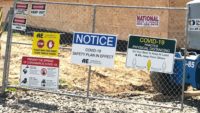The sheer volume and pervasiveness of COVID-19 cases has construction industry trade groups and others questioning the practicality of current U.S. Occupational Safety and Health Administration rule that requires workplace exposures to the virus reported and recorded.
While OSHA has no specific standard for COVID-19, the agency’s March 13 guidance considers it to be a recordable illness if the case is confirmed, meets CFR 1904.5 criteria for being work-related and requires medical treatment beyond first-aid or days away from work.
[For ENR’s latest coverage of the impacts of the COVID-19 pandemic, click here]
It’s the second requirement that the Construction Industry Safety Coalition, a group of 25 industry trade groups, says places contractors in a difficult, confusing position in compliance.
In a March 23 letter to Loren Sweatt, principal deputy assistant secretary of labor for occupational safety and health, coalition representatives argue that COVID-19 is far different from other illnesses that can be linked specifically to jobsite activities—and should be treated as such.
“Determining whether a worker contracting COVID-19 specifically as a result of the workplace environment has become virtually impossible,” says Kevin Canon, senior director of safety & health services for the Associated General Contractors, a letter author. He adds that COVID-19’s accelerating community spread defies the conventional means for contractors to trace the illness’s origins, from determining personal activities to obtaining a determination from a healthcare professional.
With health professionals already overwhelmed to combat the spiraling increase in COVID-19 diagnoses, “asking them to help make a workplace illness determination simply for recordkeeping purposes is a burden they don’t need,” Canon adds.
Another challenge is OSHA’s requirement to report work-related deaths and in-patient hospitalizations within a specific time period.
“if you don’t know whether workplace exposure occurred and caused the illness, you probably don’t know when the workplace exposure occurred,” says Avi Meyerstein, a safety attorney with Husch Blackwell, Washington, DC, in a law firm blog.
In a separate letter to OSHA, Meyerstein and other Husch Blackwell attorneys argue that “recording illnesses with speculative relation to the workplace will even cause additional economic harm because for many companies, especially contractors, recorded injury rates affect their ability to obtain or retain business.”
The coalition has asked OSHA to consider changes to the COVID-19 reporting requirements.
Suggestions include using criteria similar to those already in place for the common cold or flu, and considering virus cases exempt from the geographic presumption of being work-related. Other alternatives proposed by the coalition include limiting the work-related aspect to situations where an employee contracts COVID-19 as a result of providing direct medical treatment to a person with a confirmed case of the disease, or maintaining a separate log of cases.
“If the goal of making COVID-19 cases recordable is to provide statistics for OSHA and Bureau of Labor Statistics, the third suggestion would satisfy both parties,” Canon says.
The coalition letter also asked OSHA to consider allowing contractors to use job rotation as an alternative to N95 respirators as a means for limiting employee exposure to specific jobsite chemicals.
The approach, currently allowed just for compliance with silica dust exposure standards, would be a temporary measure implemented only with appropriate engineering measures Canon says. In addition to preventing adverse effects on workers’ health, job rotation would free up a significant volume of high-demand personal protective equipment (PPE) that contractors could transfer to healthcare providers.
“We know OSHA is mindful of the PPE shortage, and are hopeful they’ll consider the idea,” Canon says.


Post a comment to this article
Report Abusive Comment